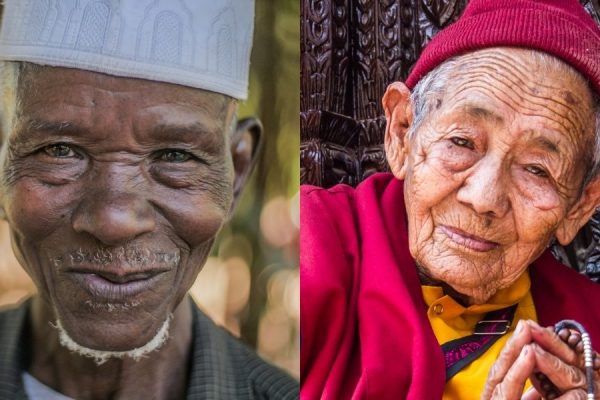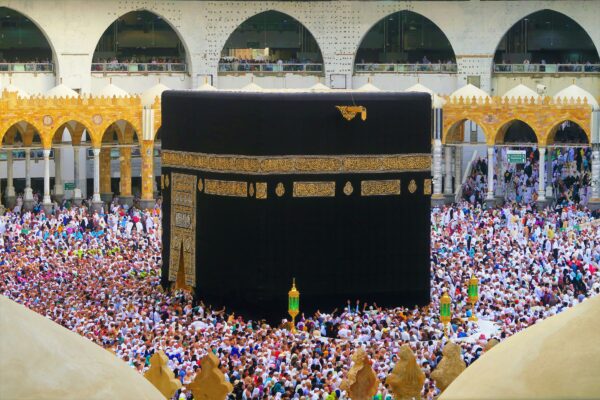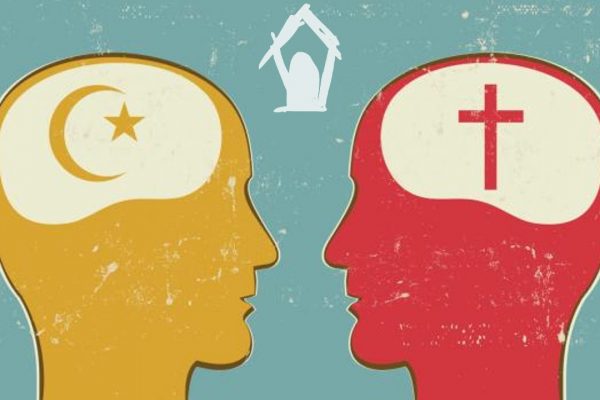The Kaaba remains an important house of worship for not only Muslims but Jewish followers as well, who believe in the strength of God and of the Abrahamic faith.
The Kaaba remains an important house of worship for not only Muslims but Jewish followers as well, who believe in the strength of God and of the Abrahamic faith.
The tafsir of Ibn Kathir (born 1302 CE) is one of the most widely used explanations of the Qur’an in the Arabic-speaking world today.
Recently, while studying Qur’an with Ibn Kathir’s tafsir, I learned of an amazing event involving two rabbis and the Holy Ka’bah. While explaining Ayah 44:37 in the Quran, Ibn Kathir relates the following events:
“One of the Tubba` left Yemen and went on a journey of conquest until he reached Samarkand, expanding his kingdom and domain. He is the one who founded Al-Hirah. It is agreed that he passed through Al-Madinah during the days of Jahiliyyah. He fought its inhabitants but they resisted him; they fought him by day and supplied him with food by night, so he felt ashamed before them and refrained from harming them.
“He was accompanied by two Jewish rabbis who advised him. They told him that he would never prevail over this city (then called Yatrib). So he retreated and took them (the two rabbis) with him to Yemen.
“When he passed by Makkah, he wanted to destroy the Ka`bah, but the rabbis told him not to do that either. They told him about the significance of this House, that had been built by Ibrahim Al-Khalil, and that it would become of great importance through a Prophet who would be sent towards the end of time.
“So he respected it, performed Tawaf around it, and covered it with a fine cloth. Then he returned to Yemen and invited its people to follow the religion of guidance along with him. At that time, the religion (Judaism) of Musa, was the religion followed by those who were guided, before the coming of the Messiah (Jesus). So the people of Yemen accepted the religion of guidance (Judaism) along with him (the Tubba king).”
Although I have been studying the Qur’an and reading other Islamic books for almost 60 years, I had never heard of these events. I think of myself as a Reform Jewish Rabbi who is a Muslim-Jew. What I mean by a Muslim-Jew is being a faithful Jew who submits to the will of God.
As a Rabbi, I am faithful to the covenant that God made with Abraham – the first Jew who was a Hanifi Muslim (a faithful monotheist), and I submit to the covenant and its commandments that God made with the people of Israel at Mount Sinai.
As a Reform Rabbi, I also believe that Jewish spiritual leaders should modify Jewish traditions, as social and historical circumstances change and develop. I also believe we should not make religion difficult for people to practice by adding an increasing number of restrictions to the commandments we received at Mount Sinai.
These are the lessons that the Prophet Muhammad taught 12 centuries before the rise of Reform Judaism in early 19th century Germany. Although most Jews today are no longer Orthodox, if the Jews of Muhammad’s time had followed these teachings of Prophet Muhammad, Reform Judaism would have started 1,400 years ago. I believe that the Prophet Muhammad was a prophet of Reform Judaism to the Orthodox Jews of his day; although he was 1,200 years ahead of his time.
During the six centuries between the birth of Jesus and the arrival of Muhammad in Yathrib, in the city of Jews (Medina), most Jews had become Orthodox Jews.
Since ibn Kathir writes that “at that time, the religion (Judaism) of Musa was the religion followed by those who were guided, before the coming of the Messiah (Jesus), peace be upon him”, we know that the events he relates took place prior to the birth of Jesus and the rise of Orthodox Judaism.
Jews first came to live in Arabia and Yemen in the centuries after the destruction of Jerusalem and its Holy House; first built in the mid-tenth century BCE by the Prophet Solomon. At that time Jewish Torah scholars were called scribes or sages.
So why was it so important for these two Jewish sages to convince the King of Tubba not to destroy the Ka’bah?
Jewish mystics often referred in their belief that there was in the high heavens above, an ideal Holy House – Beit HaKodesh – which was in some transcendent metaphorical way a House of God – Beit El.
The Qur’an states: “Their Prophet (Samuel) then proclaimed, ‘The sign of the blessings of Talut’s kingship over you is that Allah will give you back the Tabut (Ark-a wooden box placed centrally in the Tabernacle) that was taken from you, wherein is Sakinah from your Lord (inward) peace and reassurance. and a remnant of that which Musa (Moses) and Harun (Aaron) left behind carried by the angels.’ Verily, in this is a sign for you if you are indeed believers (2:248)”.
Ibn Kathir explains the statement of “carried by the angles” by quoting Ibn Jurayj who stated that Ibn `Abbas said: “The angels came down while carrying the Tabut from between the sky and the earth, until they placed it before Talut (Saul) while the people were watching.”
Thus, there is always a Holy House for monotheistic pilgrimage. When it does not exist materially in Makka or Jerusalem, it exists ideally and spiritually in the heavens above.
When it is not called Beitullah, it is called Beit El. When it is not called Bayt al-Maqdis, it is called Beit HaMiqdash; there are many names, two places on earth and one in heaven, but all of them are one.
When Abraham and Ishmael rebuilt the Holy House in Makka, there was no House in Jerusalem. When in the mid-tenth century Jerusalem Solomon built the Holy House, the Holy House in Makka that had been built by Abraham and Ishmael had already been polluted by the 360 idols the Makkans had put in it. Then in the year 587 BCE, the Babylonians destroyed the Holy House in Jerusalem. About 70 years later the Jews who had returned from exile in Babylonia rebuilt the Holy House in Jerusalem.
A generation after the death of Jesus, in the year 70 CE, the Romans destroyed Jerusalem and its Holy House. The Romans erected a triumphal arch in the Roman Forman portraying the holy Temple ’s candelabra being carried into captivity.
And all during the days of Jahiliyyah the Holy House in Makkah remained polluted until it was purified of its 360 idols by Muhammad near the end of his life. Since that time it has remained pure. The one ideal Heavenly Holy House has been rebuilt physically several times in two different holy places.
But the one God who is worshipped in each separate holy place is the one God of every place in the world. As the Rabbinic sages taught: “Why is God called Makom (place)? Because He is the place of the world, and the world is not His place (Yalqut Shimoni Vayetze 117)”.
Indeed, one of the names of God in Jewish tradition is Makom– place; because when the Prophet Jacob, who was fleeing from his hate-filled brother Esau (Genesis 27:41), he slept one night in a special place, where he had a vision of a ladder connecting heaven and earth:
“Jacob came to a certain place and spent the night there, because the sun had set; and he took one of the stones of the place and put it under his head, and lay down in that place. He had a dream: a ladder was set on the earth with its top reaching to heaven; and the angels of God were ascending and descending on it (Genesis 28:11-12)”.
The two Jewish Rabbis had protected Makkah because they knew and believed in the oral tradition that Abraham and Ishmael had rebuilt the Ka’bah. Undoubtedly, they also mourned for the Ka’bah that had been polluted by the 360 idols that had been placed in it to be worshipped.
Since Jews believe that the Holy Temple in Jerusalem will not be rebuilt until after the Messiah comes, they must have hoped that a Prophet would someday arise in Makkah and cleanse the Ka’bah of its 360 idols. And their hopes were fulfilled by the Prophet Muhammad centuries later.
Perhaps this was the reason that right after the conquest of Jerusalem by the second caliph, Umar bin al-Khattab, he headed right towards “the area where the Romans buried the Temple [bayt al-maqdis] at the time of the sons of Israel”, according to Abu Ja’far Muhammad bin Jarir al-Tabari (839-923 CE), who was a leading commentator on the Quran and is known as one of Islam’s greatest historians.
Perhaps this is also why Bronze coins were issued sometime after 696/97, five to ten years after the Dome of the Rock was built, with a seven-branched Temple menorah appearing in the center of one side, with the Shahada in Arabic stating “There is no god but Allah.” The other side, plain for all to see, was bearing the inscription: “Muhammed (is the) Messenger of God”.





